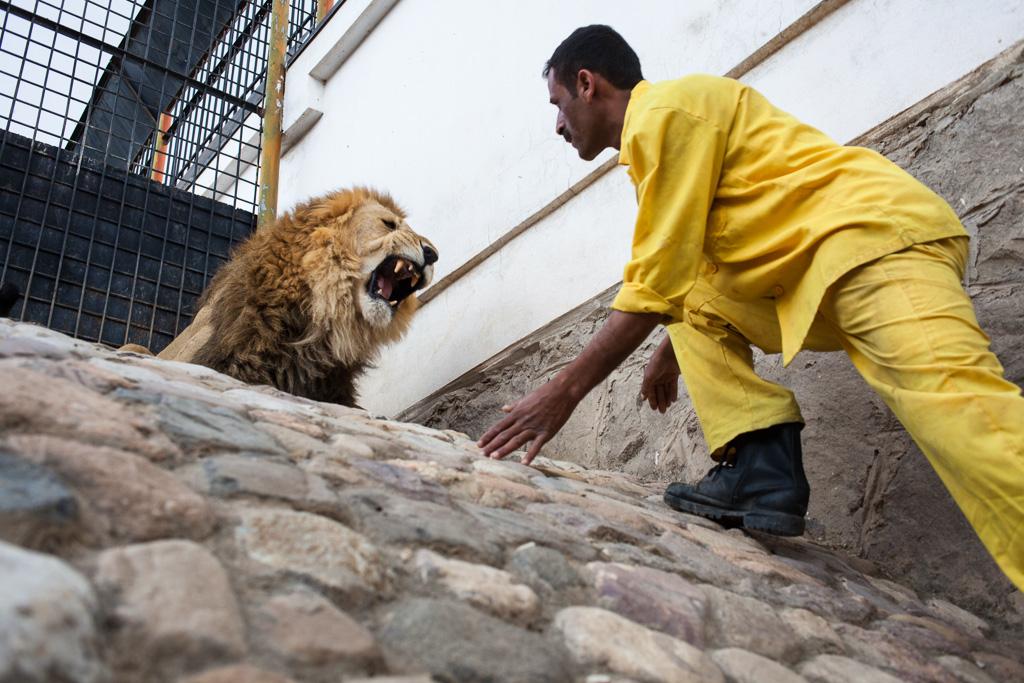A day at the zoo — in Yemen (PHOTOS)
A lion keeper at the Sana’a Zoo in Yemen’s capital approaches one of the facility’s 20 lions. Underpaid, one of the lion keepers is said to accept bribes to allow visitors to enter the cage.
SANA’A, Yemen — For just 100 riyals ($0.46), visitors of the Sana’a Zoo in Yemen’s capital can peruse a bizarre collection of animals that showcases pigeons over monkeys and alligators – and that hosts Arabian Leopards sixteen times as rare as the Giant Panda.
The animals are unhealthy, the cages are small, and the care is rudimentary at best. But the zoo’s low but quirky standards are not enough to deter pleasure-seeking Yemenis from enjoying the wildlife.
As one of the few green spaces among the city’s urban sprawl, the zoo is a weekend and holiday destination for Yemenis looking for an afternoon of entertainment amid the grinding poverty and rising insecurity that have come to characterize the country in recent years.
Some come for a picnic, a large number go to chew qat (a mildly narcotic plant popular in Yemen), and others have relented to endless demands from their children.
According to the recently appointed director, Azhar al-Nofali, the Sana’a Zoo sees hundreds of thousands of visitors each year. In part, he says, because “it is considered an outlet inside the capital.”
“I visit this zoo because my daughter and my son [like] to see the animals and the birds,” said Fawzi Sarhan, an engineer who comes periodically.
Families indeed dominate the landscape here. But groups of young Yemeni men are also a common sight. Yemen is a conservative society, so the zoo sometimes acts as a meeting place for members of the opposite sex. The combination of rich, poor, young, and old zoo patrons makes it among the more lively places in the capital.
More from GlobalPost: On Location Video: Yemeni cyclists fight for a chance to race
For the animals, life at the zoo is much less vibrant.
The zoo — one of just two in Yemen, with a population of nearly 25 million — struggles with a lack of funding, a dearth of qualified staff and a continuously growing animal population. Zookeepers sometimes throw stones at the animals, while the underpaid lion keeper is known for letting people who slip him a few hundred rials into the cage.
“It's like a death trap for a lot of animals,” said David Stanton, a biologist and long time resident of Yemen.
As the founder of The Foundation for the Protection of the Arabian Leopard in Yemen, he makes particular note of the leopards’ conditions.
“They have a very dull diet. They have dull lives. There is no enrichment. There is nothing for them to do but pace back and forth and snarl at the people who torment them,” he Stanton said. “I would like to see them displayed in an enclosure that befits the nobility of the animal.”
Stanton sees a lack of training as a major obstacle.
“I don't think there is a lot of passion. For many people it's just a job,” he said.
And poorly paid ones at that.
More from GlobalPost: Yemen: Hungering for better
The lion keeper, who is responsible for over 20 lions, makes only 27,500 rials ($128) a month. The equally underpaid employee in charge of the monkeys runs a food stand to supplement his income.
Nofali, the zoo’s director, admits his staff lacks formal training. But he says he eventually wants to raise the zoo to international standards.
In the meantime, the zoo’s relatively vegetated surroundings and strange wildlife ensure a steady stream of visitors.
